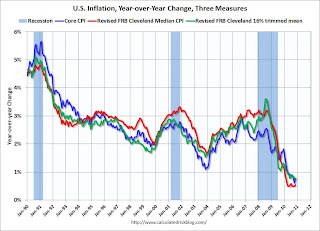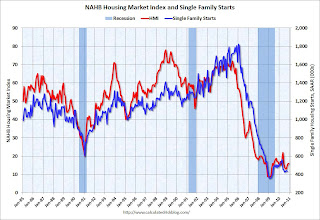by Calculated Risk on 12/15/2010 11:59:00 PM
Wednesday, December 15, 2010
Europe Update
The slow motion train wreck continues in Europe.
From the NY Times: Europe Staggers as Critical Summit Looms
Europe’s smoldering financial crisis flared up on Wednesday, with riots over austerity spending in Greece, new signs of troubles in Spain and little indication that European leaders were moving any closer to agreement on a systemic approach to long-term stability.And from the Financial Times: German MPs clash on future of eurozone
The day’s events emphasized the complex social, political and economic challenges facing government leaders at a European Union summit meeting on Thursday and Friday in Brussels.
The question is when the crisis will flare up again - and where (Spain?)
Earlier today:
• Mortgage Applications decline, Mortgage rates rise sharply
• The Empire State Manufacturing Survey showed expansion
• Industrial Production, Capacity Utilization increased in November
• NAHB Builder Confidence Flat in December
• Tax Legislation Passes in Senate 81 to 19
• Inflation: Core CPI, Median CPI, 16% trimmed-mean CPI remain below 1% YoY
Thursday:
• 8:30 AM: The initial weekly unemployment claims report will be released.
• 8:30 AM: Housing Starts for November.
Best to all
DataQuick: SoCal Home Sales off 15.5% from November 2009
by Calculated Risk on 12/15/2010 07:17:00 PM
From DataQuick: Southland Home Sales Dip; Prices Change Little
Southern California home sales fell in November to the second-lowest level for that month in 18 years, reflecting the weak economic recovery, a dormant new-home market and tight credit conditions. ...The last comment on the new-home market is one of the reasons I track the "distressing gap" (the change in the ratio between new and existing home sales). In most areas the builders just can't compete with distressed sales - although in some areas they are competing by building much smaller homes.
A total of 16,208 new and resale houses and condos sold in Los Angeles, Riverside, San Diego, Ventura, San Bernardino and Orange counties last month. That was down 3.2 percent from 16,744 sales in October, and down 15.5 percent from 19,181 in November 2009, according to MDA DataQuick of San Diego.
...
In the new-home market, sales were the slowest for a November since at least 1988. In many growth areas the math for builders just doesn’t work: The cost to construct is higher than what buyers can afford or are willing to pay. Often builders can’t compete with the pricing of nearby resale homes, especially foreclosures and short sales.
This report is consistent with Tom Lawler's initial read of 4.57 million existing home sales in November (seasonally adjusted annual rate).
Inflation: Core CPI, Median CPI, 16% trimmed-mean CPI remain below 1% YoY
by Calculated Risk on 12/15/2010 03:47:00 PM
In addition to the CPI release this morning from the BLS, the Cleveland Fed released the median CPI and the trimmed-mean CPI:
According to the Federal Reserve Bank of Cleveland, the median Consumer Price Index rose 0.1% (1.0% annualized rate) in November. The 16% trimmed-mean Consumer Price Index increased 0.1% (1.1% annualized rate) during the month. ...So these three measures: core CPI, median CPI and trimmed-mean CPI, all increased less than 1% over the last 12 months.
Earlier today, the BLS reported that the seasonally adjusted CPI for all urban consumers rose 0.1% (1.5% annualized rate) in November. The CPI less food and energy increased 0.1% (1.2% annualized rate) on a seasonally adjusted basis.
Over the last 12 months, the median CPI rose 0.5%, the trimmed-mean CPI rose 0.8%, the CPI rose 1.1%, and the CPI less food and energy rose 0.8%
 Click on graph for larger image in graph gallery.
Click on graph for larger image in graph gallery.This graph shows these three measure of inflation on a year-over-year basis.
They all show that inflation has been falling, and that measured inflation is up less than 1% year-over-year.
Note: The Cleveland Fed has a discussion of a number of measures of inflation: Measuring Inflation
 The indexes for rent and owners' equivalent rent both increased in November.
The indexes for rent and owners' equivalent rent both increased in November.It appears that rents have bottomed and are starting to increase again (this fits with earlier reports of falling vacancy rates and rising rents). I don't expect rents to push up inflation very much (I think core inflation will stay low for some time with all the slack in the system), but rising rents suggests that the excess rental housing units are being absorbed - a necessary step for an eventual recovery in residential investment.
More from Mark Thoma on inflation expectations at Economist's View: (Lack of) Inflation Watch
Tax Legislation Passes in Senate 81 to 19
by Calculated Risk on 12/15/2010 01:34:00 PM
Here is the roll call vote. On to the House ...
Commentary: Subprime Thinking
by Calculated Risk on 12/15/2010 01:01:00 PM
When I started this blog in January 2005, one of my goals was to alert people to the housing bubble, and to discuss the possible consequences of the then approaching housing bust. Residential investment has historical been one of the best leading indicators for the economy, and I was deeply concerned a major housing bust - both in terms of activity and house prices - would take the economy into recession.
There were others sounding the alarm - Robert Shiller, Tom Lawler, Dean Baker, Doris "Tanta" Dungey, and others. There was discussion of loose lending standards (including, but not limited to subprime), lack of regulatory supervision, agency problems with the originate-to-distribute model, and more. And although we might have disagreed on the exact causes of the bubble, as far as I know none of the people who are commonly credited with identifying the bubble, and predicted the bust, blamed it primarily on Fannie and Freddie or the Community Reinvestment Act (CRA).
When the Financial Crisis Inquiry Commission was announced, I was skeptical if they'd be willing to address the willful lack of regulatory supervision, and the role of Wall Street in the crisis. This morning, Shahien Nasiripour at the HuffPo wrote: Financial Crisis Panel In Turmoil As Republicans Defect; Plan To Blame Government For Crisis
The Republicans, led by the commission's vice chairman, former congressman and chair of the House Ways and Means Committee Bill Thomas, will likely focus their report on the explosive growth of subprime mortgages and the heavy role played by the federal government in pushing mortgage giants Fannie Mae and Freddie Mac to purchase and insure them. They'll also likely focus on the Community Reinvestment Act, a 1977 law that encourages banks to lend to underserved communities, these people said.How depressing.
...
During a private commission meeting last week, all four Republicans voted in favor of banning the phrases "Wall Street" and "shadow banking" and the words "interconnection" and "deregulation" from the panel's final report, according to a person familiar with the matter and confirmed by Brooksley E. Born, one of the six commissioners who voted against the proposal.
If Nasiripour story is correct, the explanations offered by these four individuals are blatantly false. Lets name names: Bill Thomas, Peter Wallison, Keith Hennessey and Douglas Holtz-Eakin. These are all subprime thinkers.
NAHB Builder Confidence Flat in December
by Calculated Risk on 12/15/2010 10:00:00 AM
The National Association of Home Builders (NAHB) reports the housing market index (HMI) was unchanged at 16 in December. Confidence remains very low ... any number under 50 indicates that more builders view sales conditions as poor than good.
 Click on graph for larger image in new window.
Click on graph for larger image in new window.
This graph compares the NAHB HMI (left scale) with single family housing starts (right scale). This includes the December release for the HMI and the October data for starts (November housing starts will be released tomorrow).
This shows that the HMI and single family starts mostly move in the same direction - although there is plenty of noise month-to-month.
Press release from the NAHB: Builder Confidence Remains Flat in December
Builder confidence in the market for newly built, single-family homes remained unchanged in December from the previous month at 16 on the National Association of Home Builders/Wells Fargo Housing Market Index (HMI), released today.
...
Two out of three components of December's HMI remained unchanged from the previous month, including the component gauging current sales conditions (which remained at 16) and the component gauging sales expectations in the next six months (which was flat at 25). The component gauging traffic of prospective buyers fell a single point, to 11.


